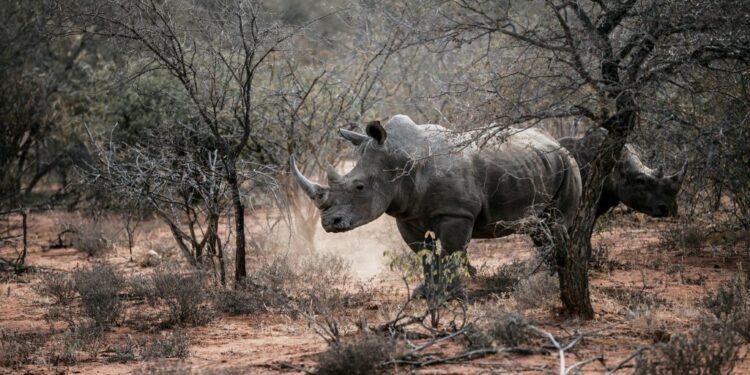On August 1, South Africa’s Department of Forestry, Fisheries and the Environment released an update that rhinoceros (rhino) poaching dropped 11% in the first half of 2023 compared to the same period of the previous year. “In the first six months, 231 rhinos were killed in South Africa. Between 1 January and 30 June 2023, poaching trends also continued to show a move away from the Kruger National Park to provincial and private reserves,” the report stated.
Over the last decade, South Africa and its Kruger National Park have become the global epicentre of the commercial illicit hunting, or poaching, of white and black rhinoceros (Ceratotherium simum & Diceros bicornis) for their valuable horns. Rhino poaching in South Africa is an ongoing challenge that has gained global attention. The nation’s preeminence as the shelter for the vast majority of the world’s rhino population makes it an appeal for deceptive actors seeking to exploit the illicit demand for rhino horns. The year 2014 was one of those years where rhino poaching reached its peak with a record 1,215 rhinos killed.
Since then, there have been concerted efforts by the South African government and various conservation organizations to combat the problem. These efforts include increased anti-poaching patrols, the use of drones and other advanced technology for surveillance, community engagement to involve local communities in conservation efforts, and stricter penalties for poachers and those involved in the illegal rhino horn trade.

The economic value of rhino horns
The illegal rhino horn trade is linked to organized crime syndicates that operate across international borders, making it a complex challenge to address effectively. Asides from South Africa, other countries in Africa, such as Namibia, Botswana, Zimbabwe, and Kenya, also face rhino poaching problems at different scales.
For decades, these nations have struggled to control the illicit poaching of rhinos whose horns are highly sorted after for jewellery and traditional medicine in Asian countries. The demand for rhino horns in Asian countries, particularly China and Viet Nam fuels rhino poaching in Africa.
Rhino horns have been used in traditional Chinese medicine for a long time, with claims that they can treat various ailments. Ancient texts like Li Shih-Chen’s 1597 medical book “Pen Ts’ao Kang Mu” suggest that rhino horns have been a part of Chinese medicine for over 2,000 years. The text mentions its use for issues like gout, rheumatism, fever, headaches, and even food poisoning when it is crushed into a fine powder. It also suggests that rhino horn could be used to treat snakebites, hallucinations, and other problems like carbuncles and vomiting. More so, it is also increasingly common in its use as a status symbol to display success and wealth.
“Rhino horns are highly prized, estimated to fetch up to $60,000 per kilo on the black market – more than the price of gold or cocaine,” Al Jazeera reported in 2017. But as of December 2022, rhino horn prices in the illegal market were forecasted to reach $400,000 per kg for Asian rhino horns and $20,000 per kg for African rhino horns.

The human element fueling poaching
While government and wildlife protectors make concerted efforts to reduce and eliminate rhino and other wildlife poaching in South Africa, other human elements still make the goal difficult. First of all, South Africa’s national parks are situated in areas of extreme poverty and are surrounded by many vulnerable communities. Thus locals have no choice but to participate directly or indirectly in the poaching of the endangered specie.
Over the years, these economically disadvantaged communities surrounding South Africa’s Kruger National Park express resentment due to the park’s profit from ecotourism, while they experience minimal benefits and employment opportunities. Historical displacement of indigenous villages for park protection has left unresolved issues of land and livelihood restoration, with many former residents still lacking proper housing and basic services. The prevailing poverty, exacerbated by high unemployment, is cited as a major factor driving poaching activities. But that is changing as the government steps up to provide more jobs and engage locals in dialogue.
Finally, despite some successes in reducing poaching numbers, the battle is far from over. Poachers continue to be a threat, using sophisticated tactics to circumvent security measures and evade authorities. While wildlife rangers and conservationists often put their lives on the line to protect rhinos from being killed for their horns, some members of the communities and even rangers still aid illegal rhino poaching activities.
Conservation efforts, public awareness campaigns, and international cooperation are vital in combatting this illegal trade and ensuring the survival of these endangered creatures. It’s important to address the root causes of demand for rhino horns and work towards changing attitudes and beliefs that drive the poaching of these endangered animals.










